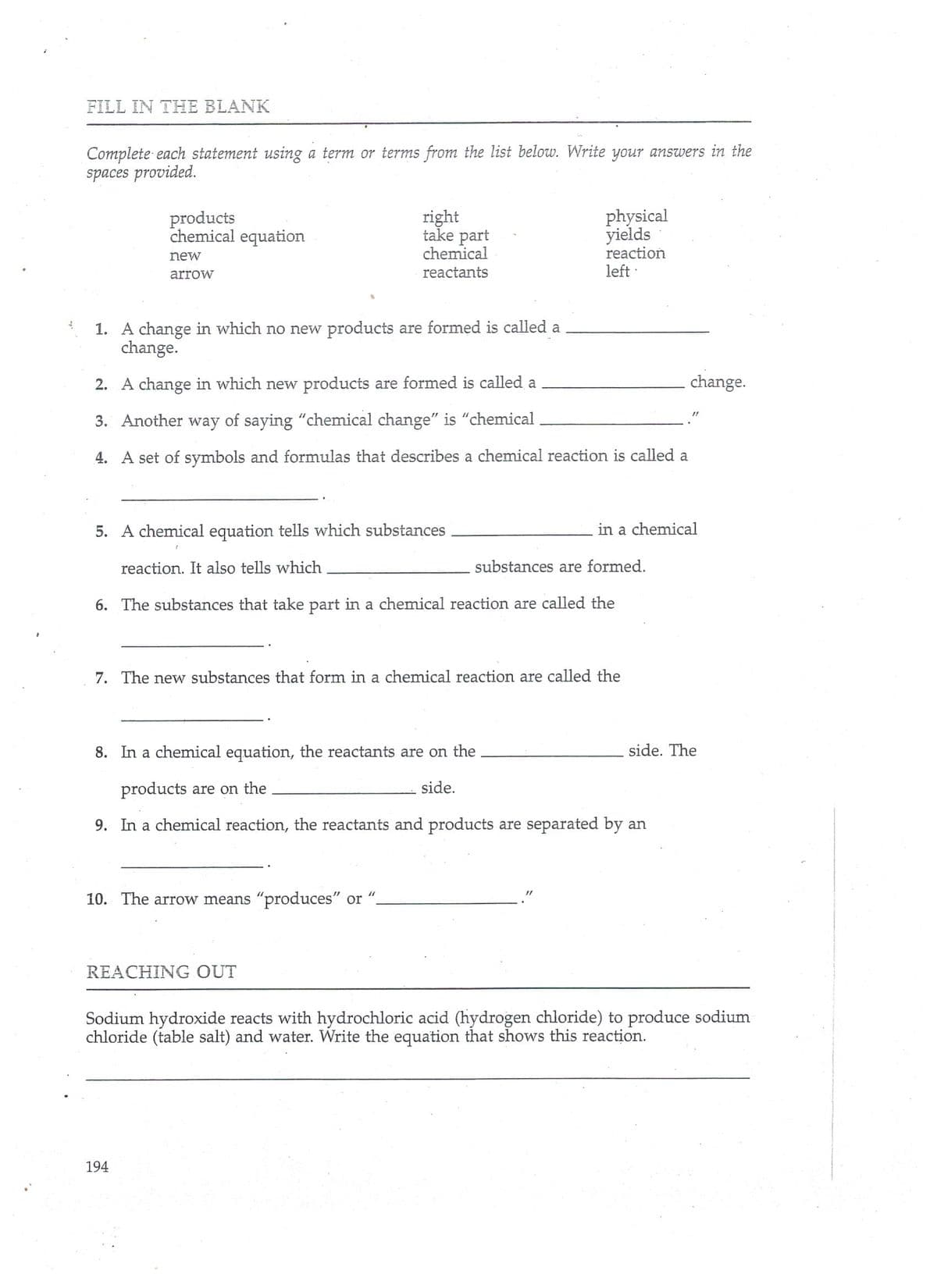FILL IN THE BLANK Complete each statement using a term or terms from the list below. Write your answers in the spaces provided. products chemical equation right take part chemical physical yields reaction left new arrow reactants 1. A change in which no new products are formed is called a change. 2. A change in which new products are formed is called a change.
FILL IN THE BLANK Complete each statement using a term or terms from the list below. Write your answers in the spaces provided. products chemical equation right take part chemical physical yields reaction left new arrow reactants 1. A change in which no new products are formed is called a change. 2. A change in which new products are formed is called a change.
Chemistry: An Atoms First Approach
2nd Edition
ISBN:9781305079243
Author:Steven S. Zumdahl, Susan A. Zumdahl
Publisher:Steven S. Zumdahl, Susan A. Zumdahl
Chapter7: Chemical Energy
Section: Chapter Questions
Problem 16Q: For the reaction HgO(s)Hg(l)+12O2(g),H=+90.7KJ: a. What quantity of heat is required to produce 1...
Related questions
Question
need help

Transcribed Image Text:FILL IN THE BLANK
Complete each statement using a term or terms from the list below. Write your answers in the
spaces provided.
physical
products
chemical equation
right
take part
chemical
yields
reaction
new
arrow
reactants
left :
1. A change in which no new products are formed is called a
change.
2. A change in which new products are formed is called a
change.
3. Another way of saying "chemical change" is "chemical
4. A set of symbols and formulas that describes a chemical reaction is called a
5. A chemical equation tells which substances
in a chemical
reaction. It also tells which
substances are formed.
6. The substances that take part in a chemical reaction are called the
7. The new substances that form in a chemical reaction are called the
8. In a chemical equation, the reactants are on the
side. The
products are on the
side.
9. In a chemical reaction, the reactants and products are separated by an
10. The arrow means "produces" or
REACHING OUT
Sodium hydroxide reacts with hydrochloric acid (hydrogen chloride) to produce sodium
chloride (table salt) and water. Write the equation that shows this reaction.
194
Expert Solution
This question has been solved!
Explore an expertly crafted, step-by-step solution for a thorough understanding of key concepts.
This is a popular solution!
Trending now
This is a popular solution!
Step by step
Solved in 2 steps with 1 images

Knowledge Booster
Learn more about
Need a deep-dive on the concept behind this application? Look no further. Learn more about this topic, chemistry and related others by exploring similar questions and additional content below.Recommended textbooks for you

Chemistry: An Atoms First Approach
Chemistry
ISBN:
9781305079243
Author:
Steven S. Zumdahl, Susan A. Zumdahl
Publisher:
Cengage Learning

Chemistry: Matter and Change
Chemistry
ISBN:
9780078746376
Author:
Dinah Zike, Laurel Dingrando, Nicholas Hainen, Cheryl Wistrom
Publisher:
Glencoe/McGraw-Hill School Pub Co

Chemistry: Principles and Reactions
Chemistry
ISBN:
9781305079373
Author:
William L. Masterton, Cecile N. Hurley
Publisher:
Cengage Learning

Chemistry: An Atoms First Approach
Chemistry
ISBN:
9781305079243
Author:
Steven S. Zumdahl, Susan A. Zumdahl
Publisher:
Cengage Learning

Chemistry: Matter and Change
Chemistry
ISBN:
9780078746376
Author:
Dinah Zike, Laurel Dingrando, Nicholas Hainen, Cheryl Wistrom
Publisher:
Glencoe/McGraw-Hill School Pub Co

Chemistry: Principles and Reactions
Chemistry
ISBN:
9781305079373
Author:
William L. Masterton, Cecile N. Hurley
Publisher:
Cengage Learning

Chemistry for Engineering Students
Chemistry
ISBN:
9781337398909
Author:
Lawrence S. Brown, Tom Holme
Publisher:
Cengage Learning

Introductory Chemistry: A Foundation
Chemistry
ISBN:
9781337399425
Author:
Steven S. Zumdahl, Donald J. DeCoste
Publisher:
Cengage Learning

Principles of Modern Chemistry
Chemistry
ISBN:
9781305079113
Author:
David W. Oxtoby, H. Pat Gillis, Laurie J. Butler
Publisher:
Cengage Learning